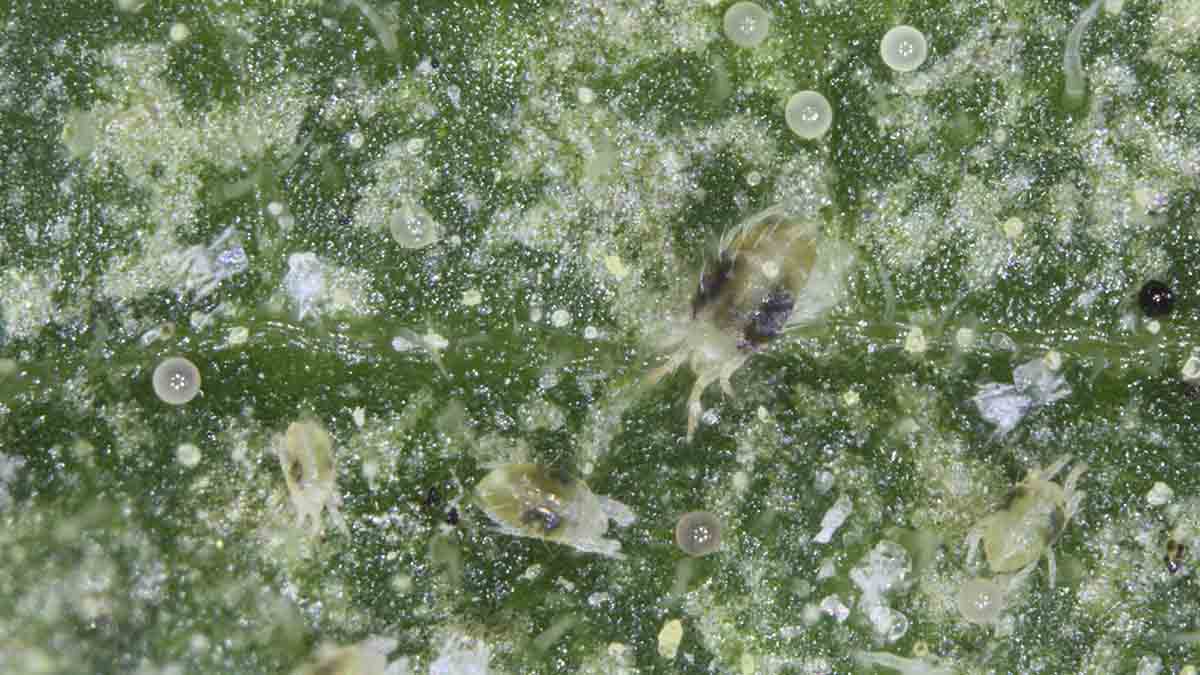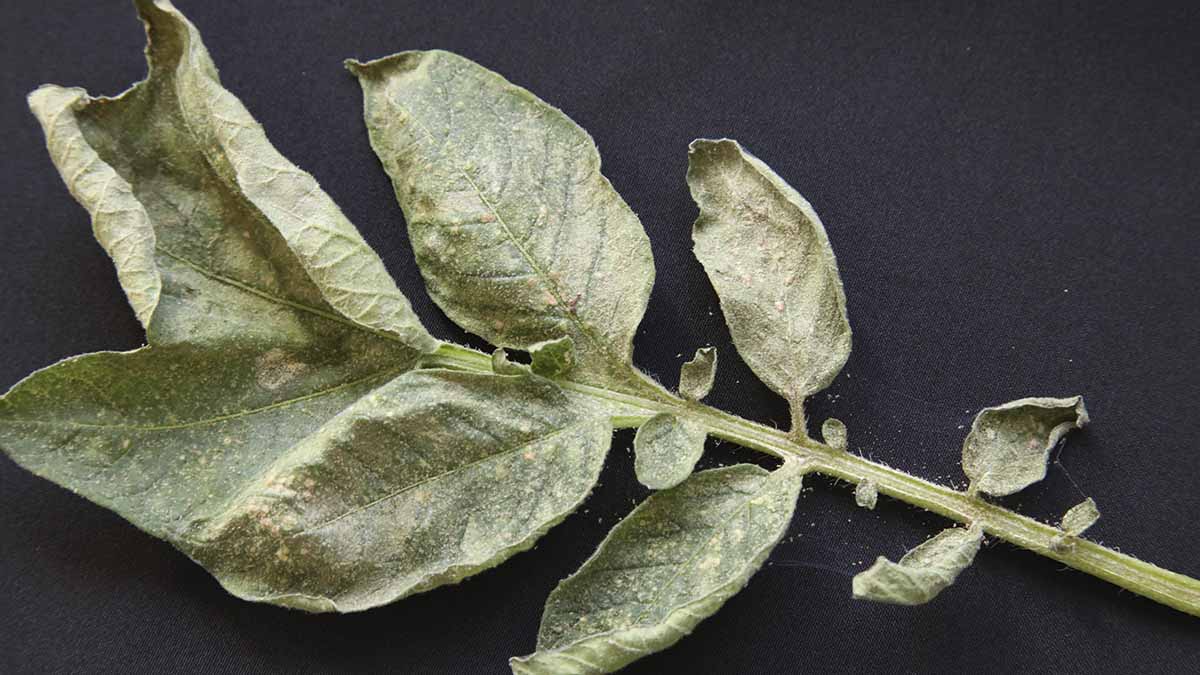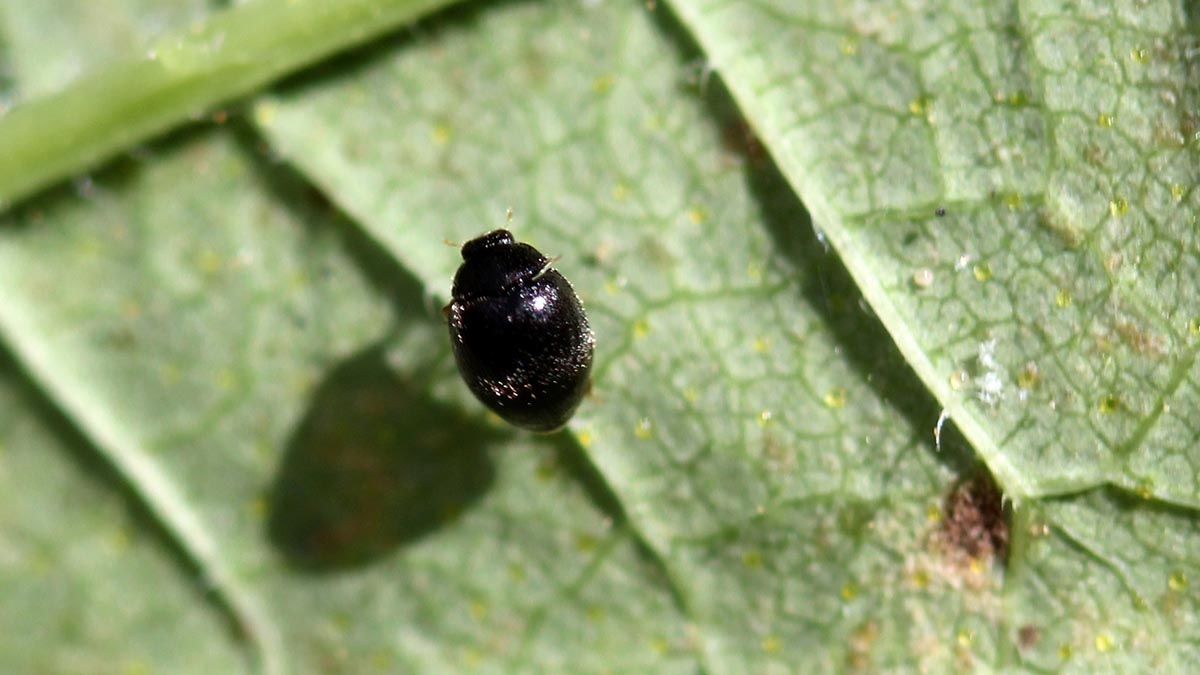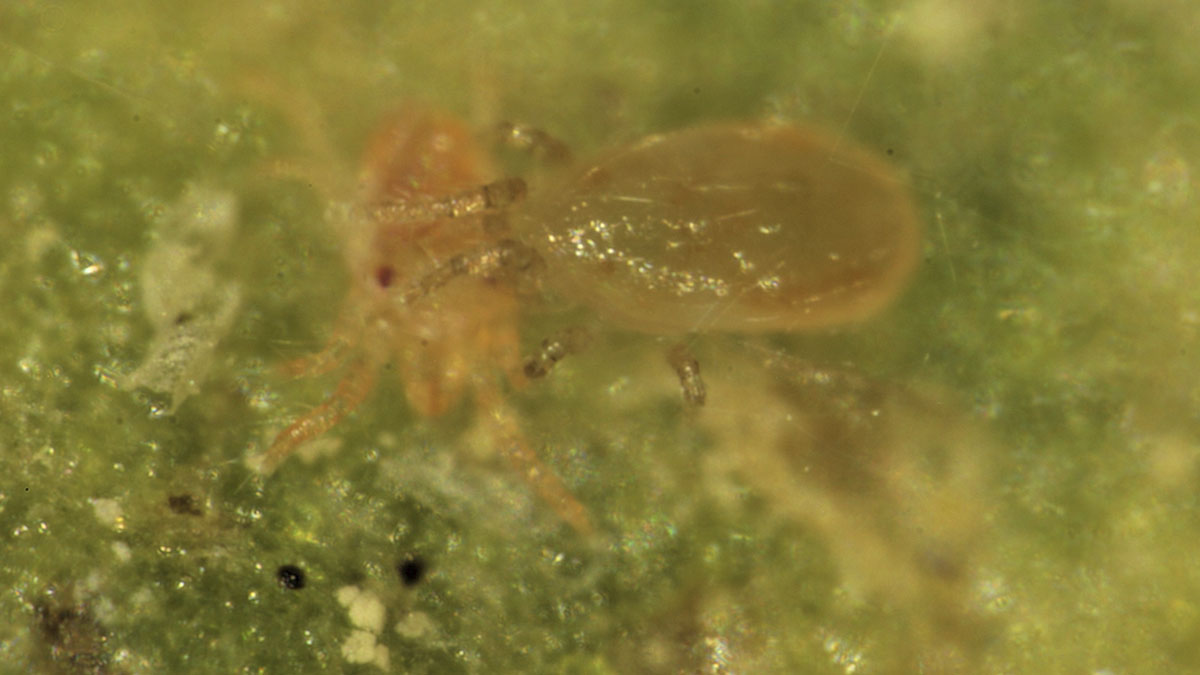Two-Spotted Spider Mite
Pest Common Name
- Two-Spotted Spider Mite (Tetranychus urticae)
- Extreme generalists, hundreds of host plants
- Crops: alfalfa, beet, corn, hemp, hops, legumes, mint, potato, sugar beet and others
- Fruits and vegetables: apple, berries, carrot, cucurbits (cucumber, squash, melon), eggplant, lettuce, pepper, tomato and others
- Ornamentals and trees: evergreens, rhododendron, rose, maple, elm and others
- Weeds: chickweed, pokeweed, wild mustard, vetch and others
Two-spotted spider mites (TSM) go through four life stages: egg, larva, nymph and adult. TSM are tiny, usually requiring a hand lens to see. Adults, nymphs and larvae are generally oval in shape, and resemble tiny spiders (Figure 1). Even adult females are only about 1/50 inch (0.5 mm) long. Immature mites, both nymphs and larvae, are similar in appearance to adults, only smaller. While adults and nymphs have eight legs, larvae have only six. Though TSM can take on a brown or red coloration, particularly late in the growing season as they prepare to overwinter, it is much more common for them to be light yellow or translucent. The two-spotted mite gets its name from the two dark patches on its sides, though these spots can sometimes merge across the back or may be entirely absent. TSM eggs are tiny, clear to white spheres that are often located in “nests” of spider mite webbing (Figure 1).

Biology
Two-spotted spider mite is common in temperate zones and is also found in greenhouses throughout the United States. Mites overwinter in ground cover (usually accumulated plant matter) or under bark of woody plants. Females emerge as temperatures increase and begin laying eggs within “nests” of webbing on host plants. Each female can live for two to four weeks and lay hundreds of eggs in her lifetime. Eggs hatch into the larval form in about three days. The mites then proceed through two nymphal stages before they reach the adult form. Lifecycles can be extremely short in optimal conditions, and there can be more than eight generations of mites per year. When populations become too dense, mites will use webbing strands to “parachute” off their host. Therefore, dense infestations (which often occur in crops like corn and alfalfa) can quickly spread to downwind plants and fields.
Damage
Two-spotted mites are extremely common and widespread, causing damage to many crops, garden plants, landscape plants and even plants grown indoors. Mites pierce leaves, flowers or fruits to feed on the fluids within their host plant, removing key fluids and nutrients. The piercing of the plant causes the development of “stippling” of the tissue. Though this stippling may start off light in color early in the infestation, it is common for damaged leaves to take on a more red or bronze coloration as time goes on (Figure 2). Severe infestation can cause leaf or whole plant death.
Damage is most likely to occur during periods of hot, dry weather when mite colony size can increase rapidly. Drought stress can also lower the plants’ ability to defend against spider mites and tolerate their damage. This interplay between drought and spider mite stress means that often damage will be most evident in late summer and early fall.

Monitoring
Scout regularly for mites, particularly during periods of hot, dry weather and after application of foliar insecticides targeting other insect pests (particularly pyrethroids and organophosphates) which can kill natural predators and cause spider mite flare-ups. Mite outbreaks may also occur in dusty sites, such as field edges along dirt roads or near weedy areas where mites can overwinter. Two-spotted mites are most likely to be found on the underside of leaves, though as infestation escalates, they may be found on the upper surface of leaves as well. Older leaves, and leaves with characteristic damage are the best place to look. Though the mites themselves can be hard to see without the help of a lens, their webbing can be seen easily with the naked eye when infestation is heavy. Shaking foliage over a piece of white paper or beat-sheet may also assist with detection of spider mites.
Economic treatment thresholds have not been established for TSM on most host plants; but generally, consider treating if infestation is evident, and hot, dry weather is likely to facilitate further colony growth. In most hosts, treatment must occur before infestation becomes severe to be effective.
Management
Primary Management Tactics
Conserving natural enemies and avoiding drought stress are among the best ways to prevent serious TSM infestations from developing.
Physical
- • Forcefully spray foliage with water to reduce mite numbers by washing them off and remove dust which fosters population growth.
Cultural
- Manage weedy areas where mites can overwinter or find alternative hosts
- Avoid water-stress in plants, which fosters mite population growth, by
- Properly irrigate plants
- Selecting drought tolerant plant varieties/cultivars
- Conserving soil moisture (e.g., by mulching)
- Avoid excess fertilization which can cause spider mite outbreaks by stressing plants and increasing nutritional value of plant sap for mites
Biological
- Conserve resident predators by avoiding broad-spectrum and long residual insecticides, as predators often keep mite numbers in check. Key predators of TSM include lady beetles known as Spider Mite Destroyers (Stethorus spp.) (Figure 3), predatory mites (Metaseiulus spp., Phytoseiulus spp.) (Figure 4), minute pirate bugs (Orius spp.) and lacewing larvae (Chrysopa spp.).
- Predators are thought to be discouraged by dust deposits on foliage, so regularly removing dust with overhead irrigation can favor predators.


Chemical
- Mite infestation often develops after applications of broad-spectrum insecticides (particularly pyrethroids and organophosphates) that remove their predators
- Consider use of insecticidal soaps and oils, which are less toxic to people and non-target organisms like predators and pollinators
- Miticides commonly used to manage TSM affect adult mites, but not eggs, so two applications, spaced about five days apart, may be necessary
- Miticides must be applied before infestations become severe, and there are no “rescue treatments” available
- Resistance to insecticides and miticides can develop rapidly, so use only when necessary and rotate between modes of action where possible
- Recommendations for pesticides to use in the management of spider mites can be found on the PNW Pest Management Handbooks website
Pesticide Warning
Always read and follow the instructions printed on the pesticide label. The pesticide recommendations in this University of Idaho webpage do not substitute for instructions on the label. Pesticide laws and labels change frequently and may have changed since this publication was written. Some pesticides may have been withdrawn or had certain uses prohibited. Use pesticides with care. Do not use a pesticide unless the specific plant, animal or other application site is specifically listed on the label. Store pesticides in their original containers and keep them out of the reach of children, pets and livestock.
Trade Names — To simplify information, trade names have been used. No endorsement of named products is intended nor is criticism implied of similar products not mentioned.
Groundwater — To protect groundwater, when there is a choice of pesticides, the applicator should use the product least likely to leach.
- Figures 1-2. Erik J. Wenninger, University of Idaho
- Figure 3. Whitney Cranshaw, Colorado State University
- Figure 4. Desireè Wickwar, University of Idaho
Desiree Wickwar, Entomologist, IPM Project Manager
Erik J. Wenninger, Professor of Entomology, IPM Coordinator
2023










